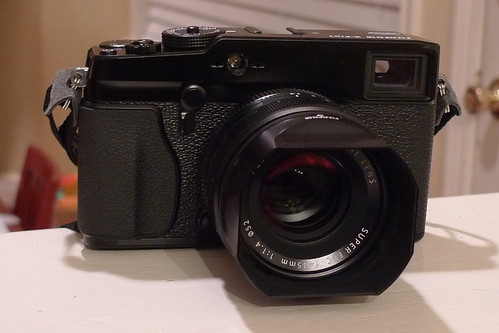Well there are a bunch of new cameras that might fit that mold, with larger sensors and interchangeable lenses. They aren't DSLRs (because they don't have a mirror box), but they can produce similar image quality. I think the industry is still searching for the best name for these cameras, but you might hear the term "mirrorless". While smaller than DSLRs they typically have slower autofocus speed than a DSLR (but faster than your P&S).
Here are some options for smaller cameras with better images which cost below $1,000 including both a camera and a lens.
Nikon
- This is Nikon’s new small interchangeable lens system.
- It’s very small and offers a reasonable step up from the point and shoot world in terms of image quality. Of all the cameras listed, the Nikon has the smallest sensor, which would likely produce slightly worse photos.
- Right now there are only 3 lenses available for it.
- The more expensive V1 offers an electronic viewfinder (useful in bright sunlight) and higher-resolution screen, while the smaller J1 features built-in flash and significantly lower price tag.
- Of the cameras listed here, only the V1 includes a built-in electronic viewfinder, but these are potential add-on accessories for the Panasonic GX1 and Olympus EP3. You don’t need one, but its nice in bright sunlight.
Nikon J1 with 10-30mm lens. $600.
Nikon V1 with 10-30mm lens. $847. Micro Four Thirds
• Panasonic, Olympus, Cosina, make up the four-thirds consortium, which is a lens mount size. The advantage is that there are lots of people making lenses and accessories for these cameras.
• The Olympus Pen Lite produces the same image as the E-P3 but it lacks a built-in flash and other do-dats.
• The Panasonic GX1 is significantly better than the GF3 in both image quality and useability, but the GF3 is very small.
Panasonic GX1 with 14-42mm lens- $700.
Panasonic GF3 with 14-42mm lens - $450
Olympus E-P3 Pen with 14-42mm lens $850.
Olympus E-PL3 Pen LITE with 14-42mm lens $650
Sony
- Sony really lacks in additional lenses for this system even though its been around for a few years now. It doesn’t have a built in flash.
Sony Nex-5n with 18-55mm lens $700.
Canon
- Canon has yet to release a large sensor, mirrorless camera, with interchangeable lenses, but they did release one with a fixed lens. This a fixed lens camera, that is slightly larger than a point and shoot, but it produces much higher image quality. Given the price and other options, I don’t see the value in this camera.
Recommendation
Buying into a system is a good idea. While you may only use the a camera and normal lens today, you can add things in the future (i.e., you are going on vacation and get a wide angle lens). Normally I prefer a fixed (non-zoom) lens that has a wider aperture, but for most of these cameras, the kit with the standard zoom lens is only a wee bit more than the body alone, so it makes sense just to get the zoom lens at the start.Of the options, I prefer the Panasonic GX1 given all the variables (image quality, price, availability of extras), but it would be best to go to a camera store and get a feel for them.








 l
l




























